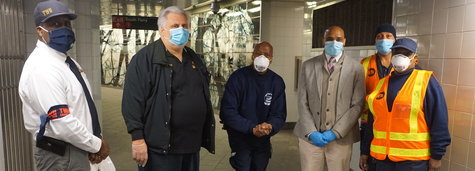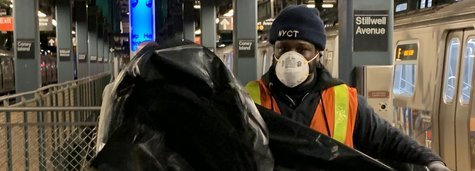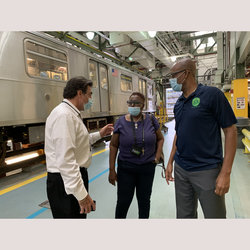Union Inspects UV Light Designed to Kill Virus on Trains
Thursday, Aug. 13, 2020 -- TWU Local 100 Secretary-Treasurer Earl Phillips and CED Vice President Shirley Martin this morning inspected subway cars with air-purification technology designed to kill COVID-19.
The technology, which features ultra-violet lights installed in the air-circulation system, creates a low dose of airborne hydrogen peroxide in the air, giving the subway car a disinfected smell reminiscent of a hospital room or doctor’s office.
The question is whether the low dose of airborne hydrogen peroxide is strong enough to kill COVID-19. An outside laboratory has taken air samples and running tests, management officials said. “We are trying to do some new and positive things,” Secretary-Treasurer Phillips said. “The virus does not discriminate. We have to work together on this.”
NYC Transit’s vice president of CMO, John Santamaria, gave Phillips, Martin and Local 100 Safety Officer Dennis Jones a tour of the technology at the Corona Barn in Queens. The NYCT Office of System Safety and the U.S. Environmental Protection Agency are also participating in the tests.
About 75% of the air in a subway car at any given time is recycling through the interior network of vents, ducts and filters, management officials said. About 25% has just been drawn into that network from outside the train car. Each subway car in the test has two sets of ultra-violet lights in the ceiling air-circulation ducts. The lights produce an undetectable dose of hydrogen peroxide in the air at a level that is far below the safety threshold established by the U.S. Occupational Safety and Health Administration, management officials said.
All of the air in a subway car is replaced with air from outside 18 times an hour, or once every three minutes, Santamaria said. All the air in a car will go through filters inside the duct every 60 seconds, he said. The air-circulation system includes vents pumping air from ceiling vents in cabs used by Train Operator and Conductors, he said. NYC Transit also is testing higher-grade filters as a possible means to reduce the transmission of the virus by riders. The New York Times recently published an explanation of the air circulation inside subway cars and you can read it here.













